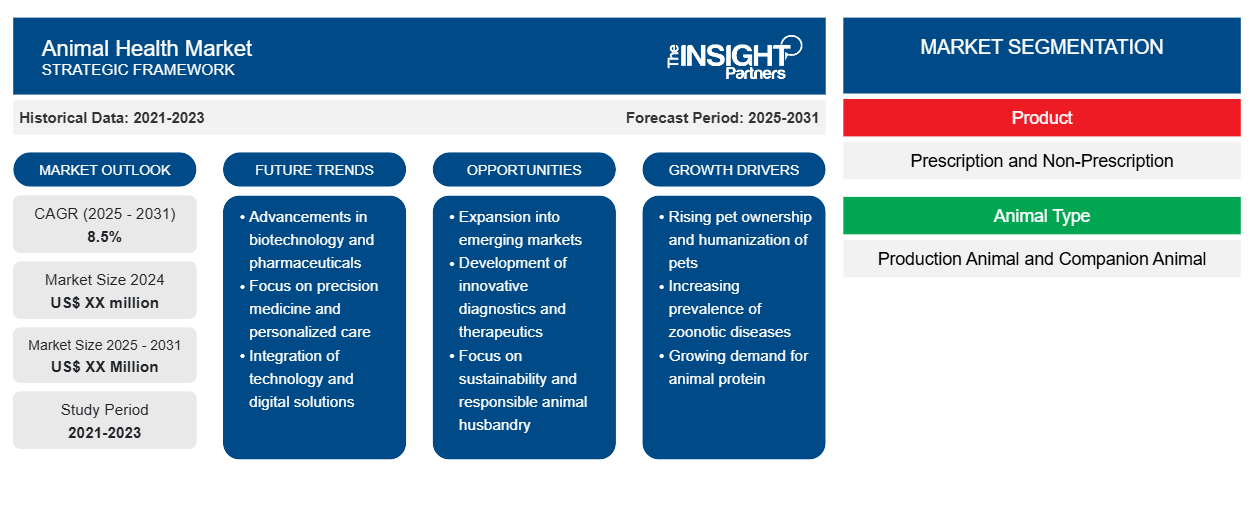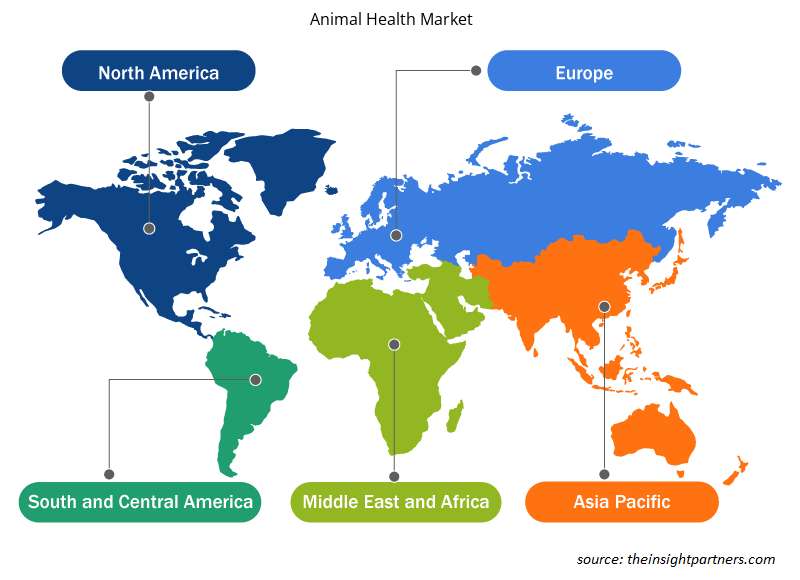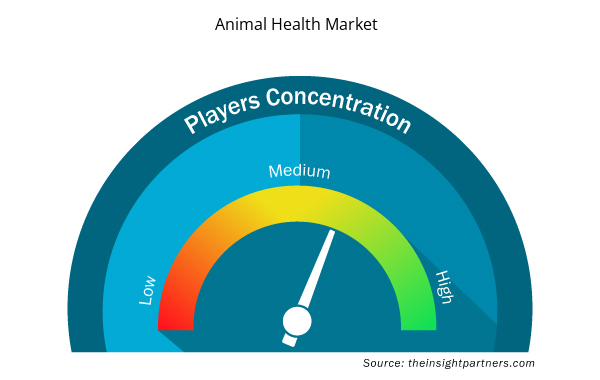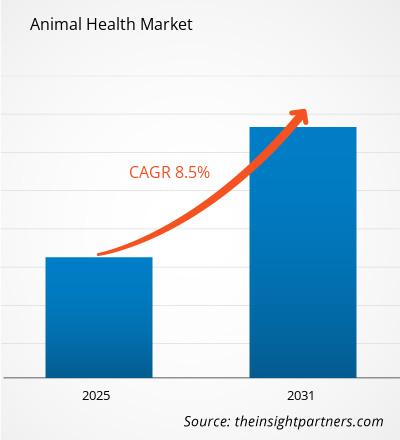The Animal Health Market is expected to register a CAGR of 8.5% from 2025 to 2031, with a market size expanding from US$ XX million in 2024 to US$ XX Million by 2031.
The report is divided into two sections: Product (Prescription and Non-Prescription) and Animal Type (Production Animal and Companion Animal). The global analysis is broken down at the regional level and major countries. The market evaluation is presented in US$ for the above segmental analysis.
Purpose of the Report
The report Animal Health Market by The Insight Partners aims to describe the present landscape and future growth, top driving factors, challenges, and opportunities. This will provide insights to various business stakeholders, such as:
- Technology Providers/Manufacturers: To understand the evolving market dynamics and know the potential growth opportunities, enabling them to make informed strategic decisions.
- Investors: To conduct a comprehensive trend analysis regarding the market growth rate, market financial projections, and opportunities that exist across the value chain.
- Regulatory bodies: To regulate policies and police activities in the market with the aim of minimizing abuse, preserving investor trust and confidence, and upholding the integrity and stability of the market.
Animal Health Market Segmentation
Product
- Prescription and Non-Prescription
Animal Type
- Production Animal and Companion Animal
Customize This Report To Suit Your Requirement
You will get customization on any report - free of charge - including parts of this report, or country-level analysis, Excel Data pack, as well as avail great offers and discounts for start-ups & universities
Animal Health Market: Strategic Insights

- Get Top Key Market Trends of this report.This FREE sample will include data analysis, ranging from market trends to estimates and forecasts.
Animal Health Market Growth Drivers
- Rising pet ownership and humanization of pets: More people are adopting pets, treating them as family members, and investing in their healthcare.
- Increasing prevalence of zoonotic diseases: Diseases that can spread between animals and humans are on the rise, increasing the need for animal health measures.
- Growing demand for animal protein: The global population is increasing, leading to a higher demand for meat and dairy products, driving the need for healthy livestock.
Animal Health Market Future Trends
- Advancements in biotechnology and pharmaceuticals: New technologies are leading to more effective vaccines, diagnostics, and treatments for animal diseases.
- Focus on precision medicine and personalized care: Tailoring treatments to individual animals based on their specific needs and genetic makeup.
- Integration of technology and digital solutions: Using technology for things like remote monitoring, telemedicine, and data analysis to improve animal care.
Animal Health Market Opportunities
- Expansion into emerging markets: Many developing countries have growing animal populations and increasing demand for animal health products and services.
- Development of innovative diagnostics and therapeutics: Creating new and improved tools for diagnosing and treating animal diseases.
- Focus on sustainability and responsible animal husbandry: Promoting animal welfare, reducing the environmental impact of animal agriculture, and ensuring responsible use of antibiotics.
Animal Health Market Regional Insights
The regional trends and factors influencing the Animal Health Market throughout the forecast period have been thoroughly explained by the analysts at Insight Partners. This section also discusses Animal Health Market segments and geography across North America, Europe, Asia Pacific, Middle East and Africa, and South and Central America.

- Get the Regional Specific Data for Animal Health Market
Animal Health Market Report Scope
| Report Attribute | Details |
|---|---|
| Market size in 2024 | US$ XX million |
| Market Size by 2031 | US$ XX Million |
| Global CAGR (2025 - 2031) | 8.5% |
| Historical Data | 2021-2023 |
| Forecast period | 2025-2031 |
| Segments Covered |
By Product
|
| Regions and Countries Covered | North America
|
| Market leaders and key company profiles |
Animal Health Market Players Density: Understanding Its Impact on Business Dynamics
The Animal Health Market market is growing rapidly, driven by increasing end-user demand due to factors such as evolving consumer preferences, technological advancements, and greater awareness of the product's benefits. As demand rises, businesses are expanding their offerings, innovating to meet consumer needs, and capitalizing on emerging trends, which further fuels market growth.
Market players density refers to the distribution of firms or companies operating within a particular market or industry. It indicates how many competitors (market players) are present in a given market space relative to its size or total market value.
Major Companies operating in the Animal Health Market are:
- Merck & Co., Inc.
- Boehringer Ingelheim International GmbH
- Ceva Santé Animale
- Cargill, Incorporated
- Zoetis Inc.
Disclaimer: The companies listed above are not ranked in any particular order.

- Get the Animal Health Market top key players overview
Key Selling Points
- Comprehensive Coverage: The report comprehensively covers the analysis of products, services, types, and end users of the Animal Health Market, providing a holistic landscape.
- Expert Analysis: The report is compiled based on the in-depth understanding of industry experts and analysts.
- Up-to-date Information: The report assures business relevance due to its coverage of recent information and data trends.
- Customization Options: This report can be customized to cater to specific client requirements and suit the business strategies aptly.
The research report on the Animal Health Market can, therefore, help spearhead the trail of decoding and understanding the industry scenario and growth prospects. Although there can be a few valid concerns, the overall benefits of this report tend to outweigh the disadvantages.
- Historical Analysis (2 Years), Base Year, Forecast (7 Years) with CAGR
- PEST and SWOT Analysis
- Market Size Value / Volume - Global, Regional, Country
- Industry and Competitive Landscape
- Excel Dataset


- Fertilizer Additives Market
- Quantitative Structure-Activity Relationship (QSAR) Market
- Dry Eye Products Market
- Artwork Management Software Market
- Semiconductor Metrology and Inspection Market
- Medical Devices Market
- Latent TB Detection Market
- Virtual Production Market
- Workwear Market
- Europe Surety Market

Report Coverage
Revenue forecast, Company Analysis, Industry landscape, Growth factors, and Trends

Segment Covered
Product, and Animal Type

Regional Scope
North America, Europe, Asia Pacific, Middle East & Africa, South & Central America

Country Scope
Argentina, Australia, Brazil, Canada, China, France, Germany, India, Italy, Japan, Mexico, Saudi Arabia, South Africa, South Korea, Spain, United Arab Emirates, United Kingdom, United States
Frequently Asked Questions
Animal Health Market is expected to grow at a CAGR of 8.5% between 2023-2031
The driving factors impacting the Animal Health Market are: Rising pet ownership and humanization of pets, Increasing prevalence of zoonotic diseases and Growing demand for animal protein
The future trends of the Animal Health Market are: Advancements in biotechnology and pharmaceuticals, Focus on precision medicine and personalized care and Integration of technology and digital solutions
Some of the customization options available based on request are additional 3-5 company profiles and country-specific analysis of 3-5 countries of your choice. Customizations are to be requested/discussed before making final order confirmation, as our team would review the same and check the feasibility.
The report can be delivered in PDF/PPT format; we can also share excel dataset based on the request.
The leading players of the market are: Merck & Co., Inc, Boehringer Ingelheim International GmbH, Ceva Santé Animale, Cargill, Incorporated, Zoetis Inc., Bayer AG, Vetoquinol SA, Nutreco N.V, Virbac, Elanco
Trends and growth analysis reports related to Life Sciences : READ MORE..
The List of Companies - Animal Health Market
- Merck & Co., Inc.
- Boehringer Ingelheim International GmbH
- Ceva Santé Animale
- Cargill, Incorporated
- Zoetis Inc.
- Bayer AG
- Vetoquinol SA
- Nutreco N.V
- Virbac
- Elanco

 Get Free Sample For
Get Free Sample For